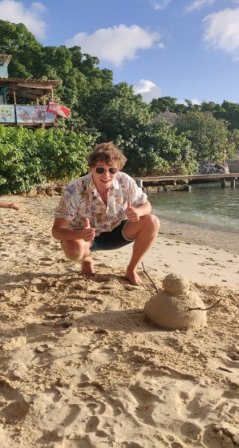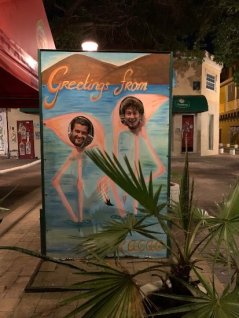
Nieuws
Newest update from Curacao
The team of MAE students led by Erik Wurz has now spent a few months on Curacao for fieldwork. Read an update on their work below by student Victor.
After 3 months the chickens have almost doubled their local CARMABI population size, you start knowing gecko’s by name who are still around every night, and you have become best friends with the cats. Days start to flow in one another and carrying Albert Hein shopping crates in and out of the water two times a day, while PADI students are gearing-up for their courses has become the norm. Also, when you are starting to wear your sweater to your morning and afternoon meetings, you then realize you have completely adapted to the Curaçao life. Meanwhile in the Netherlands, the combination of the high river waters and the freezing temperature resulted into a winter wonderland. Our social-media accounts were being bombarded with pictures of frosty snowmans and ice-skating people. Of course as a true Dutchman I was a bit jealous and decided to build myself a snowman as well uuhm…sandman I mean.

Now that we have been here on the island for quite some time, we started to pick up some local Papiamento words, ate some local food and went to some of the best dive sites on the island. But, the only thing we did not do yet, was climbing St. Christoffel mountain. The highest mountain in a radius of at least 100 kilometres reachingching a respectable 372 meters. Living at CARMABI has many advantages, one of them being around the terrestrial conservationist ranger of St. Christoffel park named Erik. So, we decided to ask him kindly if he would be willing to drive us around and tell us all about what they do. Lucky for us he was! “However, you should fist climb the mountain before sunset and be back at the park office at 9, then I’ll drive you around! Is that okay for you guys?” Yeah sure no worries! We said and off we went to our great journey to the top of the mountain. 5:30 in the morning starting the engine to be at 6 o’clock sharp at the front gate of the park. After a very sweaty climb with buzzing mosquito’s swarming around you, the view was spectacular and worth every bit! Then Erik took us for a drive in the back of his big park ranger car where we could stand in the back to look around while driving. All in all, it was a great day we enjoyed very much but back to research we went the next day.
But then... suddenly on a calm, sunny, easy-going morning we realized that our epic research is soon coming to an end. Now, we needed to think about planning our last measurements and plan the big clean-up of our work, both underwater and above. Three months ago we placed four big cages in the water to protect our babies (the corals) from getting eaten and overgrown. Now that we had done the last incubation and planted the corals safely back to their original home, we needed to fetch the cages back out of the water. That was easier said than done though… They had become overgrown by slippery algae yet the chicken-wire was still as sharp as ever, trying to rip your wetsuit with every fin-kick while we were swimming in acrobatic ways to avoid this from happening. Once out of the water, the algae that had been living on these cages gave us a lovely last fishy smell as last goodbye. Anyways, after these acrobatics performances we moved on to some last check-ups, finishing touches, and of course an ice-cold beer to celebrate our last measurements. Next-up, our final meeting from Curacao with Ronald to discuss and look-back at an educational, fun, and exciting 3 months.
